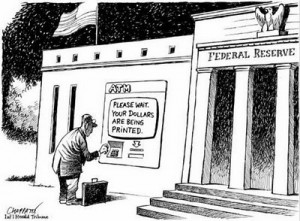Stephen S. Roach writes: Fixated on inflation targeting in a world without inflation, central banks have lost their way. With benchmark interest rates stuck at the dreaded zero bound, monetary policy has been transformed from an agent of price stability into an engine of financial instability. A new approach is desperately needed.
The US Federal Reserve exemplifies this policy dilemma. After the Federal Open Market Committee decided in September to defer yet again the start of its long-awaited normalization of monetary policy, its inflation doves are openly campaigning for another delay.
For the inflation-targeting purists, the argument seems impeccable. The headline consumer-price index (CPI) is near zero, and “core” or underlying inflation – the Fed’s favorite indicator – remains significantly below the seemingly sacrosanct 2% target. With a long-anemic recovery looking shaky again, the doves contend that there is no reason to rush ahead with interest-rate hikes.
The Fed’s presumption that the US will soon approach full employment has caused the so-called dual mandate to collapse into one target: getting inflation back to 2%.
Here, the Fed is making a fatal mistake, as it relies heavily on a timeworn inflation-forecasting methodology that filters out the “special factors” driving the often volatile prices of goods like food and energy.
This approach failed spectacularly when it was adopted in the 1970s, causing the Fed to underestimate virulent inflation. And it is failing today, leading the Fed consistently to overestimate underlying inflation. Indeed, with oil prices having plunged by 50% over the past year, the Fed stubbornly maintains that faster price growth – and the precious inflation rate of 2% – is just around the corner.
Missing from this logic is an appreciation of the new and powerful global forces that are bearing down on inflation. Rather than recognize a seemingly chronic shortfall of global aggregate demand amid a supply glut and a deflationary profusion of technological innovations and new supply chains – the Fed would rather attribute low inflation to successful inflation targeting, and the Great Moderation that it presumably spawned.
Unable to disentangle the global and domestic pressures suppressing inflation, a price-targeting Fed has erred consistently on the side of easy money.
This is apparent in the fact that, over the last 15 years, the real federal funds rate – the Fed’s benchmark policy rate, adjusted for inflation – has been in negative territory more than 60% of the time, averaging -0.6% since May 2001. From 1990 to 2000, by contrast, the real federal funds rate averaged 2.2%. In short, over the last decade and a half, the Fed has gone well beyond a powerful disinflation in setting its policy interest rate.
Over the same 15-year period, financial markets have become unhinged, with a profusion of asset and credit bubbles leading to a series of crises that almost pushed the world economy into the abyss in 2008-2009. But rather than recognize, let alone respond to, pre-crisis excesses, the Fed has remained agnostic about them, pointing out that bubble-spotting is, at best, an imperfect science.
That is hardly a convincing reason for central banks to remain fixated on inflation targeting.
Today’s enemy is financial instability. On that basis alone, the case for monetary-policy normalization has never been more compelling.

